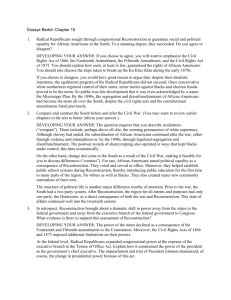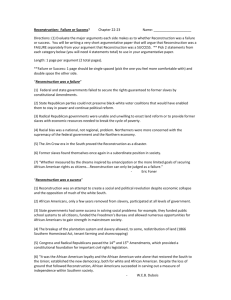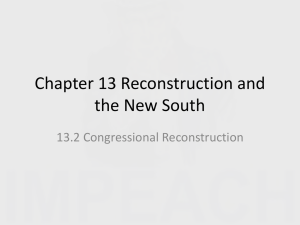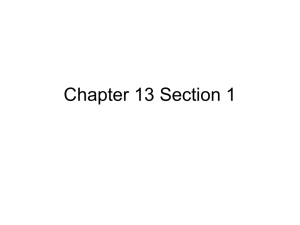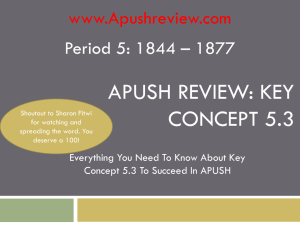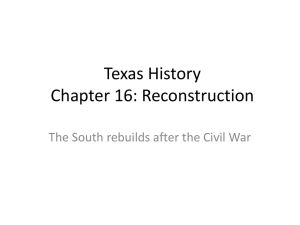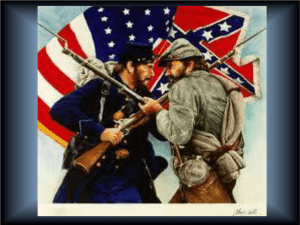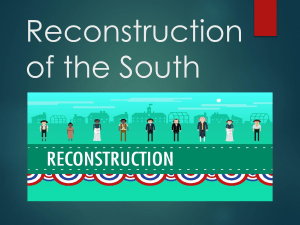Reconstruction PPT
advertisement
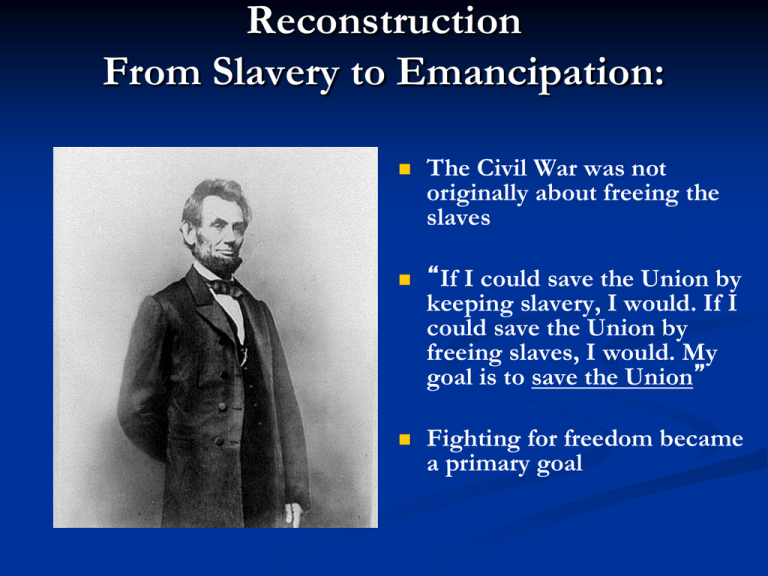
Reconstruction From Slavery to Emancipation: The Civil War was not originally about freeing the slaves “If I could save the Union by keeping slavery, I would. If I could save the Union by freeing slaves, I would. My goal is to save the Union” Fighting for freedom became a primary goal Learning Target Using your Chapter 22 Reading Guide and lecture notes, analyze multiple strengths and weaknesses of the Reconstruction effort by the North and South during the years following the Civil War. African Americans Are Free!!!, sort of… Lincoln issues the Emancipation Proclamation Frees slaves in the Southern States, which he does not have the power to do Does not free the slaves in the border states, even though he would have the power to do so Needs the Border States for support Slavery is Dead? Extensive Legislation Passed Without the South in Congress 1861 – Morrill Tariff Act 1862 – Homestead Act 1862 – Morrill Land Grant Act 1862 – Emancipation Proclamation 1863 – Pacific Railway Act 1863 – National Bank Act Reconstruction 1865-1876 Key Questions 1. How do we bring the South back into the Union? 2. How do we rebuild the South after its destruction during the war? 4. What branch of government should control the process of Reconstruction? 3. How do we integrate and protect newlyemancipated black freedmen? Wartime Reconstruction Lincoln/Johnson vs Radical Republicans 10% Plan 10 % + Plan Radical Republican Congress Accomplishments of the Radical Republicans in Congress Freedmen’s Bureau (1865) Radicals in Congress created in 1865 to help ex-slaves (early welfare agency) Gave food, clothing, medical care, & education for blacks and white refugees Educated 200,00 African Americans to read. Called “carpetbaggers” by white southern Democrats. New Rights for African Americans 13th,14th, and 15th Amendments gave African Americans new rights African Americans became citizens, slavery was outlawed, the right to vote, the right to public accommodations (hotels and trains) Shortly after the war, Grant became President. He won by 300,000 votes, of which 700,000 African Americans voted for him • Blacks eagerly set up their own schools, churches, and businesses • Two Senators, 20 Congressmen, hundreds of State Legislators th 13 Amendment Ratified in December, 1865. Neither slavery nor involuntary servitude, except as punishment for crime whereof the party shall have been duly convicted, shall exist within the United States or any place subject to their jurisdiction (abolished slavery). Congress shall have power to enforce this article by appropriate legislation. 14th Amendment Ratified in July, 1868. * Equal rights among all citizens of our country * It is illegal to discriminate 15th Amendment African American males now have the right to vote – sort of. * Provides the opportunity for states to make their own voting regulations * Poll tax * Literacy tests * Grandfather Clauses * Must own property Radical Reconstruction Acts of 1867 Tenure of Office Act The President could not remove any officials [esp. Cabinet members] without the Senate’s consent, if the position originally required Senate approval. Designed to protect radical members of Lincoln’s government. Radicals Impeach President Johnson 11 week trial Johnson agreed to stop fighting Radicals if he could stay in office. Johnson acquitted 35 to 19 (one short of required 2/3s vote) Group Question # 3 How did the white South’s uncompromising spirit and President Johnson’s political bungling open the way for the Congressional Republican program of Military Reconstruction? Radical Reconstruction Acts of 1867 Military Reconstruction Act Restart Reconstruction in the 10 Southern states that refused to ratify the 14th Amendment. Divide the 10 “unreconstructed states” into 5 military districts. Reconstruction Comes to an End 1873 Economic Depression 1874 Democrats become majority party in House of Representatives (southern pop grew due to exslaves counted in pop) Republicans Control the Senate 1876 Samuel J. Tilden (Dem) and Rutherford B. Hayes (Rep) both claim victory in presidential election Compromise of 1877 Hayes becomes president if he removes remaining troops from the South to Compromise of 1877 Group Question # 4 What was the purpose of Congressional Reconstruction, and what were it’s actual effects on the South? Purpose: * * * * Black Codes Guarantee stable subservient cheap labor supply now that blacks were emancipated. Restore pre-emancipation system of race relations. Blacks couldn’t serve on a jury, rent or lease land, and couldn’t be idle. Forced many blacks to become sharecroppers No money, no land rent is paid by working someone else’s land and paying with crops At harvest time, sharecroppers cannot cover their debt sharecropper cannot leave the farm until debt is paid JIM CROW LAWS • Jim Crow was the name of a song and dance performer • A white man who put on black face and then acted “black” It was a very popular show for decades • Jim Crow laws were laws that discriminated against AA’s • Segregation in housing, schooling, and public facilities (transportation, hospitals, trains, etc.) Segregation – separating on the basis of race Impact of 1896 landmark Supreme Court Case Plessy v Ferguson African Americans had separate schools, transportation, restaurants, and parks, many of which were poorly funded and inferior to those of whites. Belzoni, Mississippi Delta, Mississippi Roadblocks to Integration Intense racism continued New rules went largely unenforced by State and Federal Governments Emergence and acceptance of the Ku Klux Klan (KKK) African Americans in the early 1900s: “I am tired of being poor. I am tired of being lynched. I am tired of the South. I am going to move North! This movement of African Americans became known as the “Great Migration.” Many African Americans headed towards New York and in time started a cultural movement called the Harlem Renaissance. Group Question •# 5 Why did Reconstruction apparently fail so badly? Was the failure primarily one of immediate political circumstances, or was it more deeply rooted in the history of American sectional and race relations?

